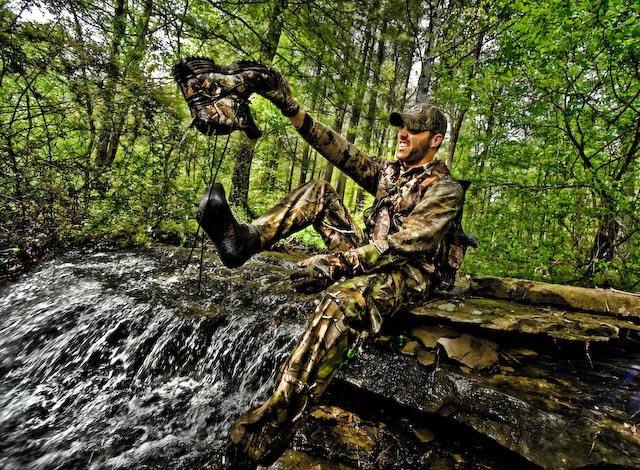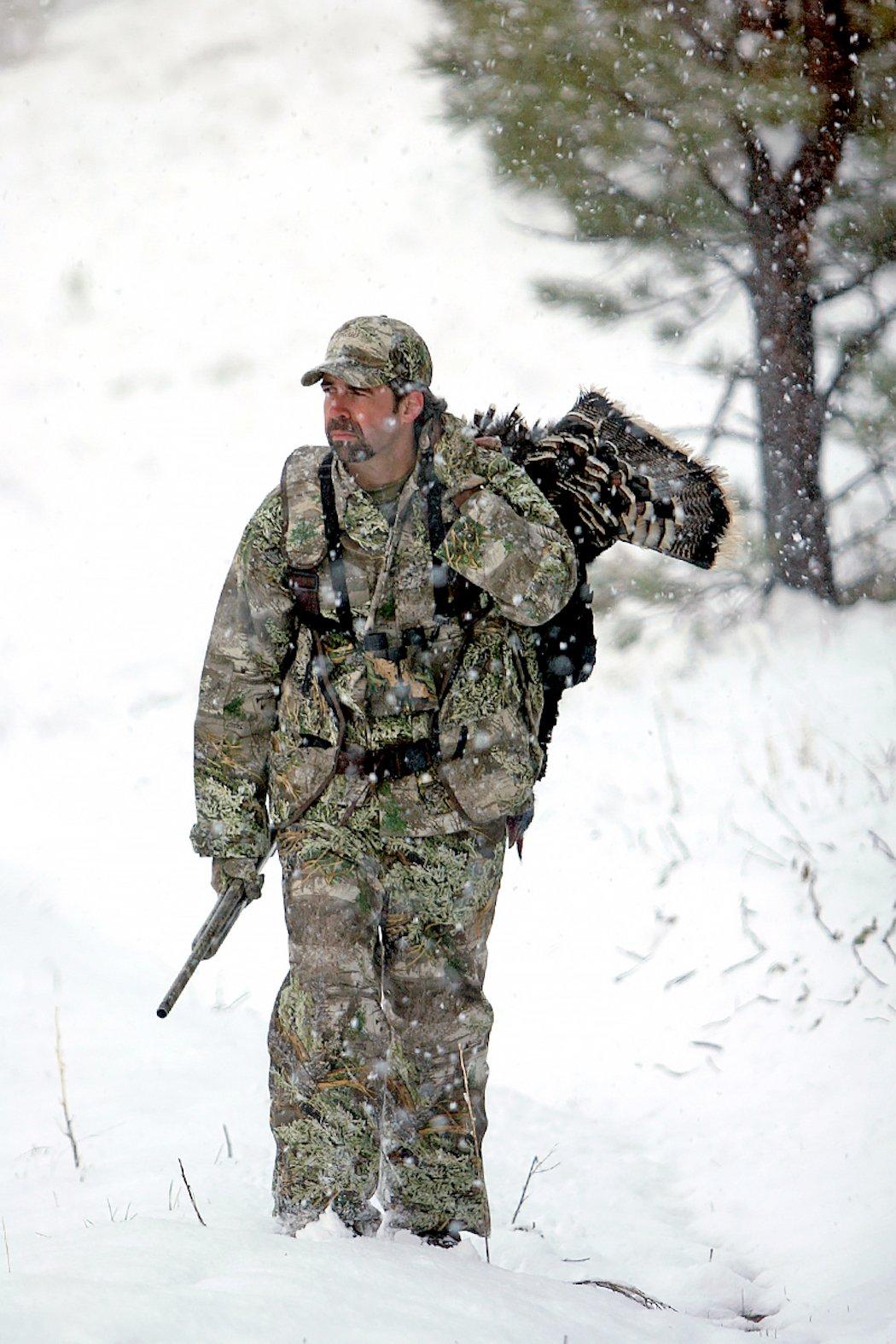Don't let the weather report keep you from hunting
Not every spring day is clear, calm and warm. In fact, those days are the exceptions. But never fear. Here's your guide to turkey hunting in any weather.
Even in the worst weather conditions, turkeys are out there somewhere. But finding them requires thinking like those birds. Paying close attention to weather patterns and developments - and understanding how turkeys are likely to react to them - is often what it takes to kill a bad-weather gobbler.
Rainy Days
If rainfall is heavy at daylight, turkeys will often delay flying down. It's not uncommon for them to sit on the limb for an hour or more after sunrise in a deluge. But, if rain hits after flocks are on the ground, the game changes. Turkeys will usually move to open fields or edge cover.
In the first scenario, simply wait them out if you can handle a long sit — or sleep in, arrive late and try to strike a bird with cold-calling. In the second instance, focus your attention on spots where field turkeys are shaking rain off their wet feathers like a Lab after a water retrieve.
- Gear to Go: Back in the day when I started turkey hunting, guys slipped friction calls into plastic bags to keep them dry. Nowadays many manufacturers offer waterproof pots and pegs, plus box calls too. Of course mouth diaphragms work no matter what the weather.
Foggy Fields
Rainy days can create post-storm fog as weather fronts shift. If it's foggy at daylight, birds will stay on the limb until the fog burns away. Often, even though they refuse to fly down, they'll gobble just fine. That can be to your advantage. Use the fog and their gobbling to slip in close, set up and be ready when they fly down. Up in the day, if fog sets in, turkey movement might increase as spring flocks transition between roosts and open areas. There they'll preen, feed, breed and just generally hang out.
If the sun appears after a steady rain or heavy fog, hustle to open hunting areas near wooded roost sites. Such conditions often create a flurry of turkey activity.
- Gear to Go: Glassing fields with your binoculars is a great way to locate spring turkeys as they transition to open areas after foggy or rainy spells. Once you pinpoint them, hatch a strategy using terrain to hide your movements, close the distance and call those birds in.
When the Wind Blows
As a goose hunter, I don't mind the wind. As a turkey hunter, I hate it.
It's not just gobbler hunters who have trouble hearing on windy days. Turkeys also have trouble hearing. The trick is to call loudly to locate male turkeys, either to induce shock gobbling or have them answer your hen yelping.
Sometimes you might just be able to pick out a single distant gobble as the wind ebbs and flows past your position. Listen hard at the bottom of a big gust of wind. Make your calls then too. If you get one to gobble, lock in on that position and hustle to it. And always assume the bird has answered you more than you've actually heard. Turkeys are easy to bump when it's windy.
Turkeys favor calmer locations like open hollows, creek bottoms, fields inside big timber and other treeless slots like power lines. With rain, fog or wind, don't squander your time hunting where turkeys won't be.
- Gear to Go: Carry an aluminum friction call or long box to really reach out to turkeys as the wind gusts. Err on the side of being louder in the woods. As ever, call with the correct cadence; just turn up the volume a bit to contact gobblers.
Hot Weather
Wild turkeys sometimes react negatively to hot weather, gobbling less often, if at all. The birds are still out there, but might be biding their time in shaded cover.
Hot conditions influence patterns too. Texas and desert southwest birds live out their feathered lives in rising mercury extremes, and seem just as active with their daily movements during hot spells as on cooler days — especially on the margins of hunting activity. I once killed a Hill Country spring Rio with the temperature over 90 degrees. He gobbled to my calls and came in on a string.
I've seen New England and New York state turkeys shut down in high heat. But sudden warm days during colder spring weather patterns will often cause a dramatic increase in turkey activity. A moderate shift from cool to warm can fire up gobbling.
- Gear to Go: Like to sit tight and even catch a power nap as you wait on turkeys to show? Good. In areas where food sources don't provide adequate moisture, turkeys will regularly visit water holes, creeks and other wet and shady locations during their daily rounds. Be there when they do.
When It Sleets and Snows
As with rain, turkeys will hit open areas if it's lightly sleeting during spring hunts. They might even huddle on field edges if slanting, steadier stuff is falling.
Snow is quite common during spring hunts in places like South Dakota, Wyoming and Nebraska. I once called in and killed a Merriam's that gobbled and strutted in as 8 inches of snow was piling up.
Out West, turkeys routinely mingle with livestock wherever spring snows cover natural food sources. If gobblers and hens pitch out of their roost and move toward these areas, you'll have to intercept them on their way there.
Deep snow can challenge turkey movements and their ability to walk to strutting zones, but hard-packed or ice-crusted snow gives them no problems. Either way, fresh snow can help you track turkeys, which is especially useful on a western hunt. Those birds stay on the move anyhow.
- Gear to Go: Dress in layers, especially during long sits in the snow. Carry along a portable seat cushion to put between your butt and the cold ground. Hypothermia isn't anything to take lightly when you're set up on mountain turkeys miles from the access road. Dress for success. Wear wind- and water-resistant clothing to keep you outdoors when everyone else has given up. Carry a change of dry camo in a plastic container in your vehicle as well.
When It's Really Bad
Tornado warnings will pass. Hollywood thunder will grow silent. Jagged lightning will fade to blue skies. Heavy rain will eventually stop. As much as I hate to write this, there are times when you probably shouldn't take the advice: You can't kill a gobbler by sleeping in.
Maybe you can. Study the weather trends and especially radar tracking. Plan on getting out when the window of time arrives as weather breaks. Some hunters have probably called it a day by then. But not you. And not that gobbler in full strut, either.
Author Steve Hickoff once killed a big Missouri longbeard during a tornado warning. They were both pretty wet but only one died.
For real-time gobbler action, check out: Spring Thunder 2020 on Realtree 365!










